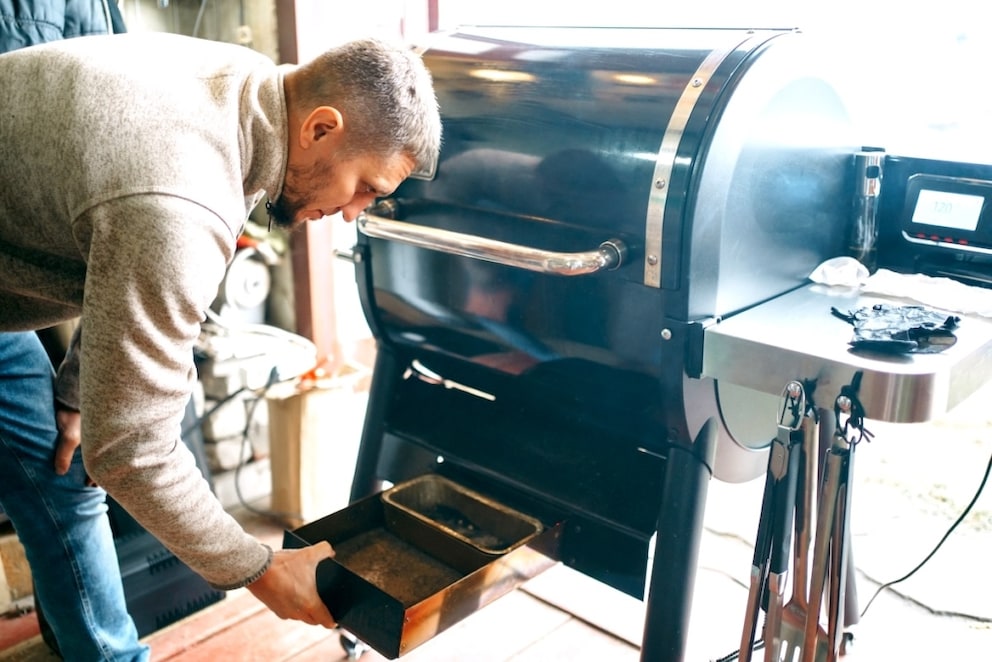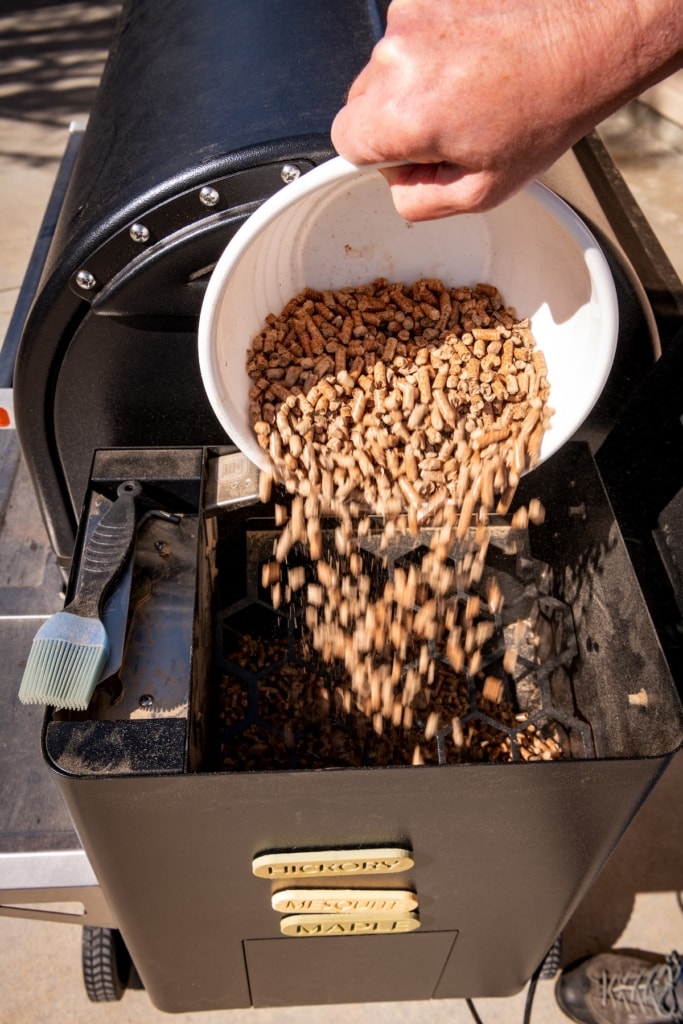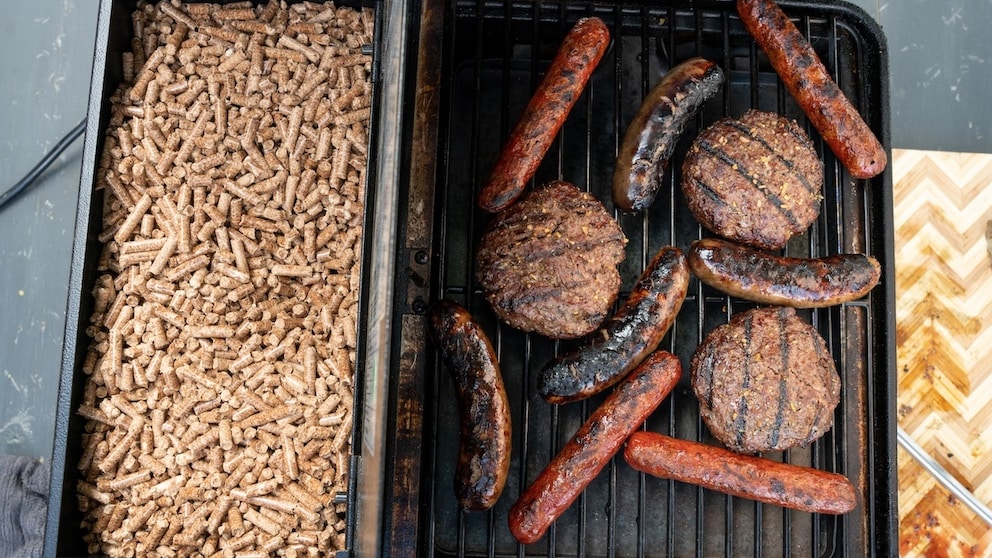April 28, 2025, 11:00 am | Read time: 10 minutes
The pellet grill is the smoker for the digital generation. In a guest article for myHOMEBOOK, grill blogger Anja Würfl explains how grilling and smoking with wood pellets work and what the concept entails.
Temperature via app, consistent cooking thanks to automatic pellet feed — and real BBQ flavor like from the southern U.S. What used to require patience and experience is now achievable for beginners with just a few button presses. Anja Würfl knows all about it — she runs her own blog, “Die Frau am Grill,” all about grilling, cooking, and everything related.
What Is a Pellet Grill?
A pellet grill looks at first glance like a mix between a smoker and a gas grill — and that’s essentially what it is. Instead of coal or gas, it uses small wood pellets stored in a hopper. An auger automatically transports these pellets into a combustion chamber, where they are electronically ignited. A fan supplies the fire with oxygen, ensuring even heat and smoke distribution.
The best part is that the temperature can be set precisely — just like an oven. Whether you want to cook pulled pork at 110 degrees for twelve hours or create a pizza with a crispy crust at 250 degrees — you only need the right program or a few button presses on the display (or the app).

Why a Pellet Grill? The Advantages at a Glance
- Precise Temperature Control: One of the biggest advantages is precise temperature control — usually directly on the device or via the app. Whether you want to smoke at 110 degrees or sear at 300 degrees — the pellet grill delivers reliably.
- Consistent Heat, Less Stress: No adding coal, no temperature chaos — the pellet grill maintains the set heat consistently. That means: more time for guests, less monitoring at the grill.
- Authentic Smoke Flavor: Despite digital technology, the BBQ factor is not lost. The wood pellets produce an authentic smoke aroma when burned — mild, spicy, or intense, depending on the wood type. This is not an electric grill with a smoke box, but real wood fire.
- Versatility on the Grill: Smoking, grilling, baking, roasting — a pellet grill is a true all-rounder. Pulled pork succeeds just as well as spareribs or even pizza, lasagna, and even bread. Some models even have a “Flame Broil” function for direct grilling over the flame.
- Smart Control: Many pellet grills are equipped with Wi-Fi or Bluetooth. This allows the device to be controlled via an app, monitor temperature trends, or set a cooking alarm — ideal for those who love technology or like to multitask.
What Are the Disadvantages of a Pellet Grill?
As ingenious as the system is, the pellet grill is not without its weaknesses. Anyone grilling with it should keep a few points in mind:
- Nothing Works Without Power: A pellet grill needs electricity for ignition, control, fan, and auger. This means: no grilling without an outlet or power bank. It’s not suitable for spontaneous BBQs by the lake or in a garden without a power connection.
- Higher Initial Cost: Good entry-level models start at about 600 to 800 euros, with plenty of room for higher prices. There are also ongoing costs for pellets, electricity, and possibly accessories like a cover, cooking chamber sensors, or app features.
- Not for Hardcore Direct Grillers: Although many models have an additional function for direct grilling over the flame, they don’t quite match the power of a gas grill with a sear zone or a charcoal grill. Those who mainly want to sizzle steaks at 400 degrees will find some limitations here.
- Cleaning and Maintenance: Ash and grease residues accumulate inside and must be removed regularly. It doesn’t take forever, but it’s more labor-intensive than with a gas grill. And yes: if you let the fan clog, you’ll notice it at the latest on the next start attempt.
What to Consider When Buying a Pellet Grill
A pellet grill is not just a pellet grill — there are worlds between a discount model and a premium smoker. To find the right device for yourself, you should pay attention to a few key points before buying:
Grill Surface and Design
How many people do you want to cook for regularly? A small grill is sufficient for a few steaks. But if you plan to make several racks of ribs or a whole brisket, you’ll need the right surface – and preferably a model with a second level (upper grill rack).
Material and Workmanship
Good pellet grills are made of powder-coated steel or stainless steel. You should look for clean welds, stable lids, and good insulation — especially if you want to grill in winter. Thin sheet metal can lose heat, which increases pellet consumption.
Control and Operation
Digital display or old-school dial? With or without app connectivity? Those who love smart features should look for Wi-Fi, meat thermometer connections, and possibly cloud programs (such as preset recipes). For purists, a simple controller with temperature selection is sufficient.
Pellet Feed and Temperature Range
A high-quality grill regulates the pellet feed precisely, keeping the temperature constant. Good models achieve 75 to 300 degrees — ideal for smoking and searing. Some professional devices even reach more than 350 degrees.
Accessories and Expandability
Is a second grill rack included? Is there a grease drip tray? Can a cast iron plate, a pizza stone, or a smoke box be retrofitted? You should also check if there are spare parts available — especially with no-name devices from the Far East, it can quickly become tight.
Known Brands and Quality
Traeger, Broil King, Weber, Pit Boss, Napoleon — these are some of the big names in the pellet grill sector. They often offer better support, longer warranty periods, and a well-developed accessory system. Slightly higher in price, but often less hassle in the long run.
Pellets — The Key to Flavor
In a pellet grill, it’s not coal or flame that delivers the aroma, but the wood pellets themselves. Therefore, it’s worth taking a closer look here — because not all pellets are the same.
What Are Pellets Anyway?
Grill pellets are made from pure, untreated hardwood — without binders, additives, or coatings. They are pressed under high pressure and usually have a size of six to eight millimeters. The difference from heating pellets from the hardware store is significant: the latter are made for stoves, not for food. So keep your hands off them when grilling!

What Types of Wood Are There — and How Do They Taste?
Each type of wood brings its own character. Here’s a brief overview:
- Hickory: Strong, smoky, slightly sweet — perfect for ribs, bacon, and brisket
- Mesquite: Very intense smoke, more for true BBQ fans — great with beef
- Apple: Mild and fruity — pairs well with poultry and pork
- Cherry: Aromatic-sweet, also gives a nice color — good for fish and poultry
- Oak: Neutral classic, good all-rounder, provides stability when smoking
- Maple: Gentle, slightly sweet — suits pork and vegetables
Many manufacturers also offer blends or flavored variants. Here you can experiment to your heart’s content.
Storage: Staying Dry Is a Must
Pellets are hygroscopic — meaning they absorb moisture. Moist pellets swell, clump, and can clog the auger. So: store them dry, preferably airtight in a barrel or bucket with a lid.
Consumption and Costs
Depending on the grill temperature, a pellet grill consumes about 0.5 to 1 kilogram of pellets per hour. A 9-kilogram bag costs between 15 and 25 euros, depending on quality and wood type. Sounds like a lot — but it saves you coal, lighters, a lot of waiting time, and grilling nerves.
What Can Be Prepared on a Pellet Grill?
A pellet grill is not just a smoker with a thermostat — it’s a multifunctional outdoor kitchen. From classic BBQ to juicy roasts to pizza or desserts: Almost anything you can do in the oven can also be done on the pellet grill — just with smoke and flair.
1. BBQ Classics: Low & Slow at Its Best
Pulled pork, ribs, brisket — this is the parade discipline. You set the temperature, place the meat on, and the grill does the rest. Many models even have programs for specific types of meat. Ideal for those who want to slowly get into smoking.
2. Pizza & Bread? Sure!
At high temperatures (250 to 300 degrees), the pellet grill works almost like a pizza oven. With a pizza stone, you get a crispy crust and slightly smoky aromas — even baguettes or flatbread turn out really well.
3. Fish and Poultry
Delicate ingredients like salmon, trout, or chicken benefit from the mild smoke and even heat. You don’t have to worry about drying out — especially fish, which stays super juicy on the pellet grill.
4. Vegetables and Vegetarian
Whether grilled corn, stuffed peppers, smoked eggplant, or even grilled cheese: Veggie fans also get their money’s worth. Smoke adds depth to the flavor — perfect for meatless options with grill character.
5. Desserts? Yes, Really
Smoked apple crumble, grilled pineapple, or brownies from the cast iron pan — sweet dishes also work on the pellet grill. The smoke gives the dessert an exciting, almost caramel-like note.

Gas barbecue safety: 6 mistakes that many people make when checking their gas barbecue

Is there a German company behind the barbecue manufacturer Weber?

Heat Pump in an Apartment Building? The Most Important Questions and Answers
Tips for Beginners: How to Get Started
A pellet grill takes a lot of work off your hands — but there are still a few things to keep in mind to get the best out of the device from the start.
First Burn In, Then Get Started
Before placing the first steak, you should run the grill empty once (about 30 to 45 minutes at 200 to 250 degrees). This “burn-in” burns off production residues, seals the interior surfaces, and ensures a clean start.
Quality in Pellets Pays Off
Good pellets = good taste. Therefore, you should look for grill pellets made from pure hardwood without additives. Cheap varieties can cause too much ash or uneven burning — you’ll notice it in the meat (and in the cleaning).
Always Fill the Hopper
Nothing is more annoying than an empty pellet container in the middle of a long job. So, it’s better to add a handful more than too little. Many grills also show how much is left — it’s worth taking a look.
Don’t Forget the Grease Drip Tray
To avoid grease fires, you should always keep the tray under the grill clean and regularly check the grease drains. Especially during long jobs with a lot of dripping juice, this is an important point.
Use Temperature Probes
Instead of relying on the cooking chamber display, you should use meat thermometers, preferably with two probes (one for the food, one for the environment). Many grills offer this directly, some even via app with an alarm function.
Don’t Check Too Early
Lid open = heat out. Especially during long jobs, you should be patient. Better to wait 30 minutes longer and then be rewarded with the aroma.

